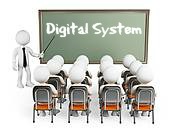
Digital radio has additional processing inside the radio to convert the original analog voice into digital format (“ones and zeros”) before transmitting the signal in digital form over-the-air. The receiving radio receives the digital signal and converts it back into analog signal so the user can hear the voice.
Examples of digital radio are radios that comply with APCO-25 standard or TETRA standard.
The digitalization is done by sampling the voice frequency and then changing the sampled information to “ones and zeros”. This is done using an electronic circuit called a voice coder or vocoder. Depending on type of vocoding techniques, the Vocoder also “compressed” the resulting sample so that it can fit into a narrower bandwidth. Examples of speech coding (vocoding) technique are IMBE (Improved Multi Band Excitation) used by APCO-25 standard or VSELP (Vector Sum Excited Linear Prediction) used by TETRA standard.
Because the receiving radio just need to identify the binary information (ones and zeros), the receiving radio can replicate the original voice as long as it’s able to identify the “ones and zeros” signal. Thus, a digital signal has fairly consistent quality as it moves away from the transmitter until it reaches a threshold distance.
As digital radio systems send voice transmissions in digital form, listeners using an FM analog scanner hear only noise on the channel. This gives an added benefit for privacy from public news organization or casual listeners.
To further secure the over-the-air transmission from listeners who have more sophisticated equipment, an encryption feature is required. Encrypted voice protects the voice message from being intercepted and understood by listeners. On analog radio systems, voice scrambling may cause audio quality to vary. For years, many users have accepted degraded audio quality for the benefit of secure voice transmissions. With digital radio systems, encrypted voice has no perceived degradation of quality where encrypted voice sounds the same as clear voice on a digital radio system.
One of the most significant benefits of digital radio systems is that the integration between voice and data services is greatly improved. Because the voice transmissions are treated as data, there is much better and tighter integration between voice and external data devices. In addition, digital transmissions over-the-air are further improved for error protection, a great feature for wireless mobility. The integration of voice and data is one of the compelling reasons why users want to upgrade their system to digital.
Because digital voice transmissions are already in digital format over-the-air, it is now possible to imbed more signaling features in the same voice transmissions. Today, analog radios have signaling features, but these tend to be limited to smaller amounts of data than the digital equivalent. Digital radios allow for the signaling to be transmitted continuously and concurrently with the voice transmissions. These signaling features furnish quick and appropriate information alongside the voice, such as the caller identification in which the recipient can identify the sender, call alert feature or text message. Other enhanced features are also possible using these embedded digital signaling features.
Digital radio system offers the capability to serve more users than in the same comparable analog spectrum. This is due to the use of compression during vocoding process. The resulting compressed information can be then send using narrower band with while maintaining similar original quality. By using narrower bandwidth, it allows more simultaneous talking paths in one analog channel spectrum. This benefit is important in an environment where regulatory body constraints spectrum utilization.
Category: LEARNING CENTRE
Tags: digital, radio system, TRBO, xpr